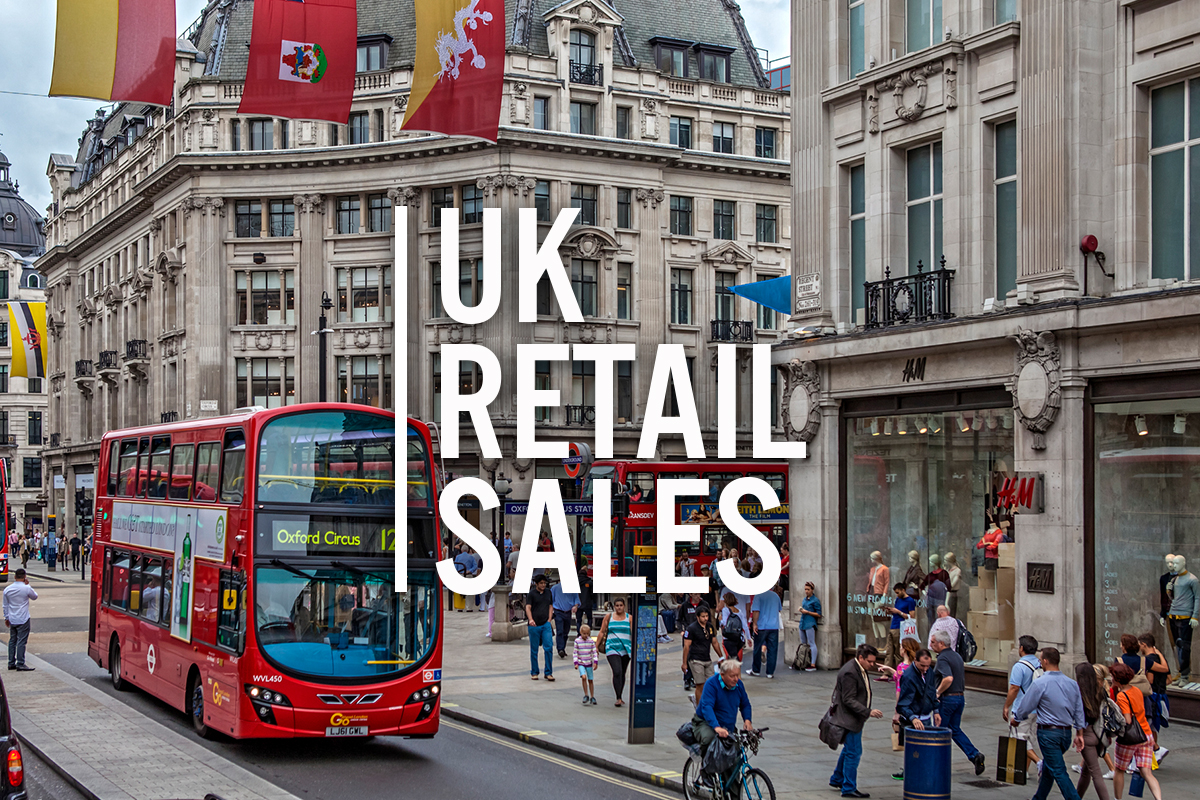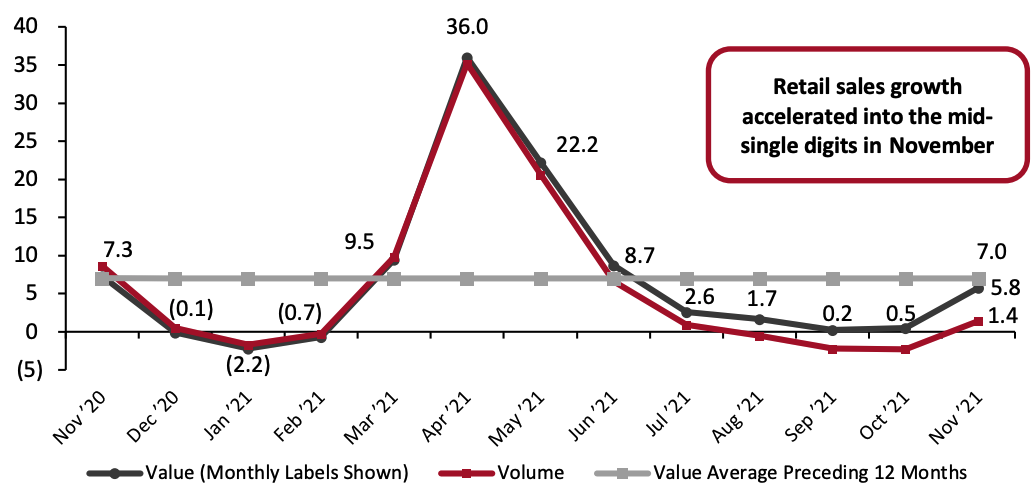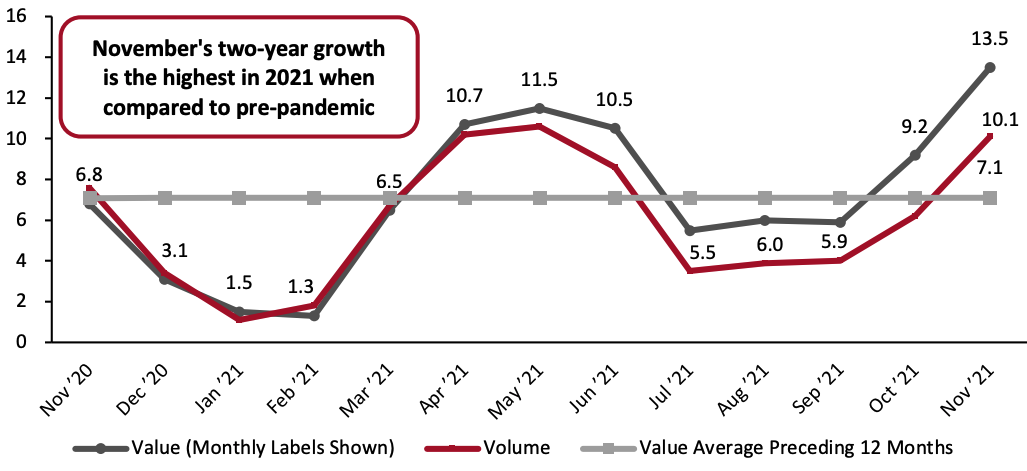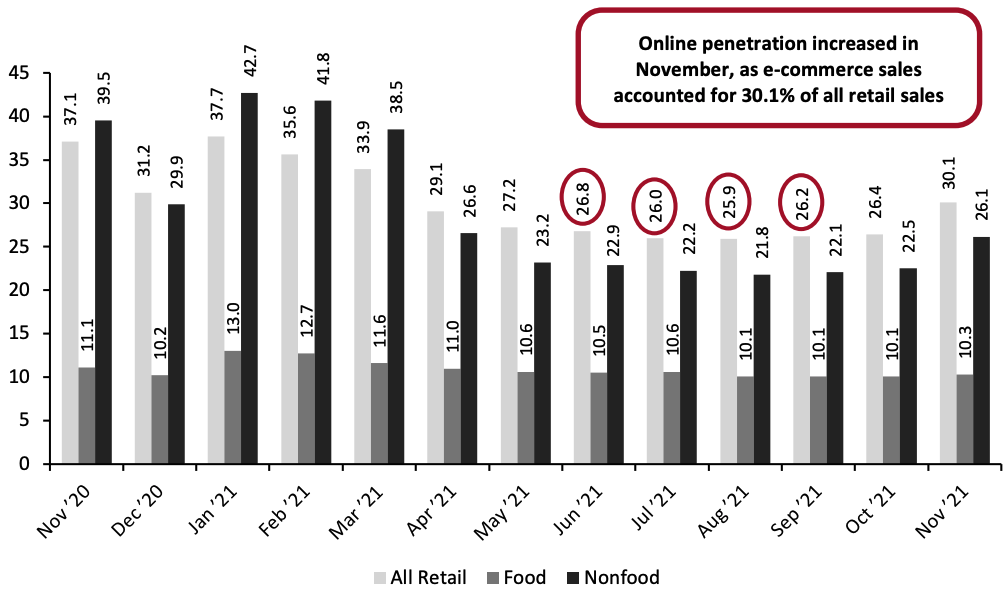
Nitheesh NH
UK Retail Sales: November 2021
Year over year, total retail sales excluding automotive fuel grew by 5.8%, a substantial acceleration from October’s 0.5% revised year-over-year growth. On a two-year basis, November retail sales grew strongly by 13.5% compared to pre-pandemic values—the largest two-year growth in decades. Growth was likely driven by consumers making holiday purchases earlier this year due to supply chain challenges. The highest shop-price inflation for a decade (since October 2011) of 4.4% supported the expansion of sales by value although, as charted below, volume growth turned positive, too, on a year-over-year basis. Total growth was led by a strong month of sales at books and news stores, clothing specialists, and computers and telecoms equipment retailers. Large retailers, who account for the bulk of retail sales, saw sales growth accelerate in November to 6.7%, up from October’s revised modest 2.0% growth year over year. Retail sales growth was driven this month by an increase in sales volumes in clothing stores, computer stores, jewelry stores and toy stores. According to the ONS, retailers pointed towards strong trading related to Black Friday and the lead-up to Christmas as growth drivers.Figure 1. Total UK Retail Sales (ex. Automotive Fuel and Unadjusted): YoY % Change [caption id="attachment_138341" align="aligncenter" width="700"]
 Data in this report are not seasonally adjusted
Data in this report are not seasonally adjustedSource: ONS/Coresight Research[/caption] November UK retail sales reflect strong consumer spending before the discovery and spread of the Omicron variant. Last week, UK officials estimated that Omicron infections had reached 200,000 a day and were continuing to rise rapidly, sending many into a 10-day isolation (as of December 18, 2021, over 37,000 Omicron cases have been confirmed in the UK, according to the UK Health Security Agency, but only a sampling of positive tests are checked to see which variant is involved, so the true total for Omicron is certainly much higher). Previously, Prime Minister Boris Johnson had implemented stricter social guidance such as lockdown regulations to combat high case numbers and the Scientific Advisory Group for Emergency (SAGE) have recommended introducing lockdown restrictions. We expect the spread of the Omicron variant to hinder consumer spending in stores, likely slowing December retail sales as we close out 2021. Two-Year Growth Against the more consistent comparatives of 2019, November retail sales growth represents the strongest month of sales growth in 2021. At 13.5%, November retail sales growth surpassed May’s peak of 11.5%.
Figure 2. Total UK Retail Sales (ex. Automotive Fuel and Unadjusted): % Change from Two Years Prior [caption id="attachment_138343" align="aligncenter" width="700"]
 Data in this report are not seasonally adjusted
Data in this report are not seasonally adjustedSource: ONS/Coresight Research[/caption] Retail Sales Growth by Sector The lockdown measures imposed last year had a major detrimental impact on retail sales, causing certain sectors to see dramatic sales declines and skewing year-over-year growth numbers. To control for the effects of the pandemic in 2020’s retail sales figures, we largely compare November 2021 sales to pre-pandemic November 2019 sales in this section. In a strong month for clothing sales, the specialist sector saw growth on a two-year basis accelerate from October to reach 6.8% in November, while year-over-year growth jumped to 56.9%. Its complementary sector, footwear specialists, marginally recovered to surpass pre-pandemic values—posting a sales growth of 0.1%. Compared to November 2020, footwear sales improved by 61.4%. Department stores and mixed-goods retailers also recovered to surpass pre-pandemic values in November, posting a two-year sales growth of 3.0%. Year-over-year sales were flat—however, this is an improvement from October’s negative growth compared to 2020. Floor covering specialists have traditionally been a volatile sector in the ONS index. This month, floor covering specialists saw a 136.8% increase in sales compared to 2020, a stark contrast from sales declines seen in September and October. Against pre-pandemic 2019 values, floor covering specialists saw a 13.2% sales increase. Despite the global microchip shortage, the computers and telecoms equipment sector continues to perform strongly against the weak 2020 comparatives: Sales increased by 37.3% year-over-year in November. Compared to pre-pandemic, sales grew by 15.2%. The health and beauty sector continued to perform strongly when compared to its pre-pandemic values: On a two-year basis, the sector grew by 10.6%. Compared to 2020, this sector posted more modest gains of 3.8%.
Figure 3. UK Retail Sales, by Sector: YoY % Change [wpdatatable id=1564] [wpdatatable id=1565]
*A small retailer is defined as one with fewer than 100 employees or with revenues of £60 million or less per year; all others are large retailers **A relatively fragmented sector, in which reported figures have traditionally been volatile Source: ONS
Online Retail Sales Decline by 14.4% Despite high overall retail sales growth in November, online sales declines continued to accelerate during the month. In November, online sales declined by 14.4% compared to a year ago, surpassing October for the largest decline in online sales in 2021. Non-food retailers reported a large decline in online sales of 21.1%, while online food retail also saw substantial sales declines of 8.3%. Household goods stores saw the largest year-over-year decline in online sales of 32.8%, while textile, clothing, and footwear stores decreased by 5.8%. As shown in the figure below, online sales as a percentage of overall retail in November accelerated, rising from October’s 26.4% revised figure to 30.1% in November.Figure 4. Online Retail Sales as % of Total Retail Sales [caption id="attachment_138345" align="aligncenter" width="700"]
 “Food” and “Nonfood” data are for store-based sectors; “All Retail” total includes nonstore retail, which is not charted
“Food” and “Nonfood” data are for store-based sectors; “All Retail” total includes nonstore retail, which is not chartedSource: ONS[/caption] Covid-19 Lockdown Timeline Lockdown 1: The UK was put into lockdown on March 23, 2020, initially for three weeks, in an attempt to limit the spread of the coronavirus. Nonessential retail stores were closed. On April 16, the government extended the lockdown by another three weeks. On May 11, Prime Minister Boris Johnson announced that the government would begin easing restrictions in a phased manner, allowing nonessential stores to reopen from the start of June. However, garden centers were allowed to reopen from May 13 and furniture stores from May 23. On May 26, the government announced that all nonessential retailers in England and Northern Ireland—including department stores and small independent shops—would be allowed to reopen from June 15, but stores would need to implement measures to meet the necessary social distancing and hygiene standards. On June 23, Johnson announced that restaurants, pubs, museums, cinemas and hotels could reopen on July 4. On September 14, a new “rule of six” prohibited social gatherings of more than six people, unless they are from the same household. On September 22, Johnson outlined a slew of new restrictions in the wake of a fresh spike in the number of infections. These included the closing of bars, pubs and other hospitality services by 10:00 p.m., effective September 24. On October 7, the Scottish government implemented tighter restrictions, largely on the hospitality industry. Retail was not directly affected, although stores were requested to enforce two-meter distancing. On October 12, the UK government announced a three-tier lockdown system, which classifies regions based on the severity of infection rates. In the week beginning October 19, a number of regions in England, including London and Manchester, moved into higher “tiers” of control, which include restrictions on households mixing and, in some cases, some service industries; however, these did not change the direct rules for retailers. On October 23, a 17-day lockdown began in Wales, with nonessential retailers being forced to close once more. Lockdown 2: On October 31, Prime Minister Johnson announced a second lockdown for England for the period November 5 to December 2. All nonessential retail was forced to close, “including, but not limited to, clothing and electronics stores, vehicle showrooms, travel agents, betting shops, auction houses, tailors, car washes and tobacco and vape shops.” Food shops, supermarkets, garden centers and certain other retailers providing essential goods and services could remain open. Nonessential retail could remain open for delivery to customers and click- and-collect. Hospitality venues such as restaurants, bars and pubs were forced to close but could still provide takeaway and delivery services. Also forced to close were entertainment venues, indoor and outdoor leisure facilities, and personal care services. Following the lockdown, UK regions were placed into different tiers, each of which had different restrictions. On December 8, the UK’s National Health Service started vaccinations, with the aim of vaccinating the most vulnerable groups of people by February 15, 2021. On December 21, the UK government scrapped a planned easing of rules on the mixing of households over the Christmas period. In England and Scotland, households in many areas were banned from mixing; in some areas, households could mix on Christmas Day only. The devolved Welsh and Northern Irish administrations implemented their own restrictions. Lockdown 3: On January 4, 2021, Johnson announced a lockdown in England, effective January 5 and with an unspecified end date but with laws formally expiring on March 31. Scotland, Wales and Northern Ireland also implemented lockdowns. On January 19, Scotland’s First Minister Nicola Sturgeon announced that that country’s lockdown would be extended until at least the middle of February. On January 27, the government announced that travelers arriving from “red list” countries must quarantine in hotels specified by the government. On February 22, the government laid out a roadmap to ending lockdowns in England. Restrictions started to be eased from March 29, nonessential retail stores and services such as hairdressers were allowed to reopen from April 12, and final restrictions were ended on June 21. On March 25, the UK lowered the Covid-19 risk level from four to three on a scale of five. On April 12, the government eased raft of restrictions across England, with gyms, zoos, theme parks, pubs and restaurants allowed to reopen for outdoor service and shops and hairdressers again permitted to serve customers. On April 20, Sturgeon announced that Scotland would move to Covid protection Level 3 from Level 4 on April 26, meaning hospitality venues such as cafés, pubs and restaurants and beauty salons could reopen. On May 17, England eased restrictions further with groups of up to six people from different households allowed to socialize indoors, pubs and restaurants can serve indoors and entertainment venues such as museums, cinemas, and theatres can reopen. On June 14, England delayed the final stage of easing lockdown restrictions by month, until July 19, due to the increase in cases of the more transmissible Delta variant. After more than a year under some form of restriction, England lifted almost all remaining Covid-19 rules on July 19, 2021. This included the opening of nightclubs and lifting capacity restrictions on big events and performances. Presently, the number of new coronavirus cases has increased again in England owing to the spread of the Omicron variant. On December 13, British Health Secretary Sajid Javid announced that approximately 200,000 people nationwide had tested positive for the Omicron variant. On December 14, Prime Minister Boris Johnson introduced a new policy of vaccine certification to enter nightclubs and other crowded public spaces. As of December 18, 2021, over 37,000 Omicron cases have been confirmed in the UK, according to the UK Health Security Agency, but only a sampling of positive tests are checked to see which variant is involved, so the true total for Omicron is certainly much higher.